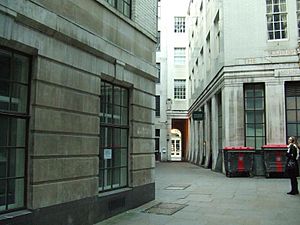Exchange Alley facts for kids
Exchange Alley (also known as Change Alley) is a small, narrow street in the old part of the City of London. It connects different shops and coffeehouses. This alley was a handy shortcut between the Royal Exchange (a famous trading building) and the Post Office on Lombard Street.
Many interesting shops used to be found here. You could find ship chandlers (who sold supplies for ships), people who made telescopes and other tools for navigation, and goldsmiths from Italy.
In the 1600s and 1700s, the coffeehouses in Exchange Alley became very important. Places like Jonathan's and Garraway's were early meeting spots for trading shares (parts of companies) and commodities (like goods or raw materials). These activities eventually led to the creation of the modern London Stock Exchange.
Another famous coffeehouse, Lloyd's Coffee House, was the start of Lloyd's of London. This is a major insurance market, along with Lloyd's Register (for shipping) and Lloyd's List (a shipping newspaper).
The closest London Underground station to Exchange Alley is Bank. The nearest main train station is Cannon Street.
The Story of Exchange Alley
Before the Royal Exchange was built in 1565, Lombard Street and Change Alley were open-air meeting places for London's business people. In 1698, a man named John Castaing started printing the prices of stocks and goods at Jonathan's Coffeehouse. This was one of the first signs of organized trading in London.
Many stock jobbers (people who bought and sold stocks) were not allowed in the Royal Exchange because they were too noisy. So, they moved their business to Jonathan's and Garraway's coffeehouses.
Big Events and Changes
Change Alley was the location of some very important events in England's financial past. One of the most famous was the South Sea Bubble, which happened between 1711 and 1720. This was a time when many people invested in the South Sea Company, hoping to get rich quickly. However, the company's value crashed, and many investors lost a lot of money.
Edward Matthew Ward's painting, "The South Sea Bubble, a Scene in 'Change Alley in 1720'," shows how people were trying to make money and how foolish some investors were. Even though the collapse of the South Sea Company was a big problem, it also helped shape how finance works in England today. It led to the creation of private banks and a strong market for financial assets.
In 1748, a large fire started in Exchange Alley at a shop that made wigs. The fire spread quickly, burning down between 90 and 100 houses in Exchange Alley, Cornhill, and Birchin Lane. Many people lost their lives. The fire also destroyed several famous coffeehouses, including Garraway's and Jonathan's. A rare collection of butterflies, owned by the Aurelian Society, was also lost in the fire.
In 1761, a group of 150 brokers and jobbers (people who trade stocks) formed a club. They built their own building in Sweeting's Alley in 1773. This new building was first called "New Jonathan's" but was later renamed the Stock Exchange. This shows how the informal trading in coffeehouses grew into a formal financial institution.
Maps of the Area
-
John Rocque's Map, 1747






